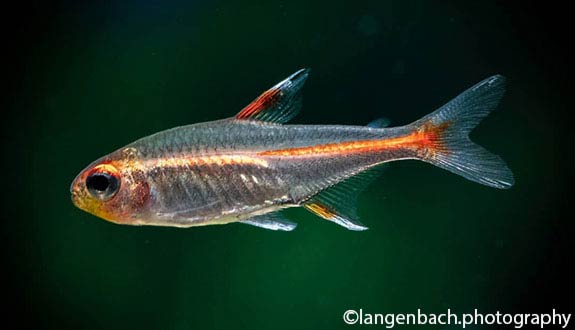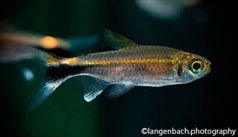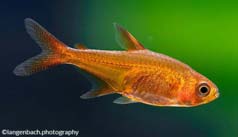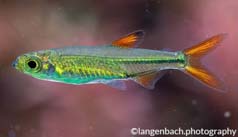

Alternative species (click on the thumbnail to see the card)
Names
Scientific name
Hemigrammus erythrozonus
Common name
Glowlight tetra
Origin

Origin: Guyana
Biotope: Amazonian
Dimorphism

The male is slender unlike the female which has a rounded abdomen. She's also slightly taller than the male.
Group

Characidae
Volume

80 L / 18 imp gal / 21 US gal
Parameters

T°: 24 to 28°C or 75 to 82°F
pH: 5.5 to 7
Hardness: 6 to 15°dGH
Difficulty

Easy
Size

4.5cm (1.6")
Longevity

2 to 5 years
Living zone
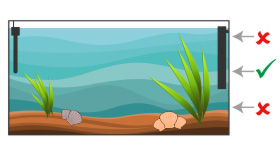
Middle
Individuals

10
Food
How to feed the Glowlight tetra?
Food
How to feed the Glowlight tetra?
Omnivorous: it easily accepts all forms of food.
Behavior
What kind of behavior does the Glowlight tetra have?
Behavior
What kind of behavior does the Glowlight tetra have?
Pacific with all, if not a little shy. Like all species of the genus, it is gregarious and must be kept in a school. The larger the group of Hemigrammus erythrozonus, the more comfortable and natural the fish will be and the more natural their behaviour will be.
Cohabitation
Who can live with the Glowlight tetra?
Cohabitation
Who can live with the Glowlight tetra?
Community baccalaureate accepted (it does not pay much attention to other baccalaureate residents). You can associate it with Danios, Rasboras, Pencil Fish, other Grouse. It will also go very well with groundfish such as Corydoras, or small Loricariidae. Surface fish such as Gouramis may also be suitable, as well as dwarf cichlids (Apistogramma).
Beware of predation by large fish.
Breeding
How to breed the Glowlight tetra?
Breeding
How to breed the Glowlight tetra?
Reproduction is possible but quite delicate. Place a male and a female (but also possible in a group) in a laying trough (20 litres / 4 Imp Gal / 5 US Gal) with a protective grid and fine-leaved plants such as Java moss. The tank is dimly lit. A peat filtration will be a plus as well as the use of osmosis water. Temperature 24°C (75°F) and KH at 2°. Beforehand, separate the sexes and prepare for spawning by feeding the parents plenty of live prey. Introduce the parents in the evening, spawning should take place the next day. As soon as the eggs appear, remove the adults. Incubation lasts 19 hours. The fry are very sensitive to nitrates.
Feed the fry: infusers, artemia and cyclops nauplia.
Its aquarium
Which aquarium for the Glowlight tetra?
Its aquarium
Which aquarium for the Glowlight tetra?
A little shy by nature, he likes the profusion of plants and hiding places. On the other hand, in a not very furnished decoration, this fish will tend to tarnish.
The best is to keep it in an aquarium in an Amazonian biotope. To do this, opt for peat filtration.
On the decoration side, make a beautiful arrangement of twisted roots or driftwood. For a natural effect, the substrate will be river sand on which you will place dried leaves (beech or oak). These leaves will tint the water with a colour close to that of tea. Replace these leaves before they rot.
On the plantation side, the only rule is that it should be dense and lush, but still leave space for swimming.
Finally, dim the lighting with floating plants.
In such a planter, the Glowlight tetra will show you its most beautiful colours!
Good To know
Find all additional information!
Good To know
Find all additional information!
He has a heart condition and is very vulnerable to white spot disease. Avoid stress and plan for a very gentle and least stressful acclimatization to avoid the onset of illness. For the same reasons, place the tray in a quiet place.
Apart from that, this species remains a good choice for beginners because it is hardy and inexpensive.
Yours photos!
Comments
Sort by:
Please login to post comments
